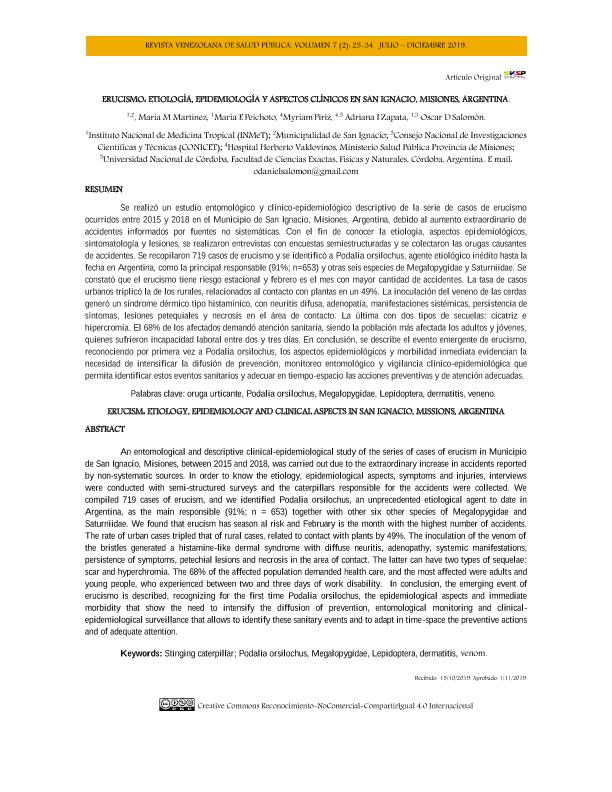Mostrar el registro sencillo del ítem
dc.contributor.author
Martínez, María M.
dc.contributor.author
Peichoto, María Elisa

dc.contributor.author
Piriz, Myriam
dc.contributor.author
Zapata, Adriana Inés

dc.contributor.author
Salomón, Oscar Daniel

dc.date.available
2020-07-16T17:25:27Z
dc.date.issued
2019-11
dc.identifier.citation
Martínez, María M.; Peichoto, María Elisa; Piriz, Myriam; Zapata, Adriana Inés; Salomón, Oscar Daniel; Erucismo: etiología, epidemiología y aspectos clínicos en San Ignacio, Misiones, Argentina; Universidad Centroccidental Lisandro Alvarado; Revista Venezolana de Salud Publica; 7; 2; 11-2019; 25-34
dc.identifier.issn
2343-5526
dc.identifier.uri
http://hdl.handle.net/11336/109425
dc.description.abstract
Se realizó un estudio entomológico y clínico-epidemiológico descriptivo de la serie de casos de erucismo ocurridos entre 2015 y 2018 en el Municipio de San Ignacio, Misiones, Argentina, debido al aumento extraordinario de accidentes informados por fuentes no sistemáticas. Con el fin de conocer la etiología, aspectos epidemiológicos, sintomatología y lesiones, se realizaron entrevistas con encuestas semiestructuradas y se colectaron las orugas causantes de accidentes. Se recopilaron 719 casos de erucismo y se identificó a Podalia orsilochus, agente etiológico inédito hasta la fecha en Argentina, como la principal responsable (91%; n=653) y otras seis especies de Megalopygidae y Saturniidae. Se constató que el erucismo tiene riesgo estacional y febrero es el mes con mayor cantidad de accidentes. La tasa de casos urbanos triplicó la de los rurales, relacionados al contacto con plantas en un 49%. La inoculación del veneno de las cerdas generó un síndrome dérmico tipo histamínico, con neuritis difusa, adenopatía, manifestaciones sistémicas, persistencia de síntomas, lesiones petequiales y necrosis en el área de contacto. La última con dos tipos de secuelas: cicatriz e hipercromía. El 68% de los afectados demandó atención sanitaria, siendo la población más afectada los adultos y jóvenes, quienes sufrieron incapacidad laboral entre dos y tres días. En conclusión, se describe el evento emergente de erucismo, reconociendo por primera vez a Podalia orsilochus, los aspectos epidemiológicos y morbilidad inmediata evidencian la necesidad de intensificar la difusión de prevención, monitoreo entomológico y vigilancia clínico-epidemiológica que permita identificar estos eventos sanitarios y adecuar en tiempo-espacio las acciones preventivas y de atención adecuadas.
dc.description.abstract
An entomological and descriptive clinical-epidemiological study of the series of cases of erucism in Municipio de San Ignacio, Misiones, between 2015 and 2018, was carried out due to the extraordinary increase in accidents reported by non-systematic sources. In order to know the etiology, epidemiological aspects, symptoms and injuries, interviews were conducted with semi-structured surveys and the caterpillars responsible for the accidents were collected. We compiled 719 cases of erucism, and we identified Podalia orsilochus, an unprecedented etiological agent to date in Argentina, as the main responsible (91%; n = 653) together with other six other species of Megalopygidae and Saturniidae. We found that erucism has season al risk and February is the month with the highest number of accidents. The rate of urban cases tripled that of rural cases, related to contact with plants by 49%. The inoculation of the venom of the bristles generated a histamine-like dermal syndrome with diffuse neuritis, adenopathy, systemic manifestations, persistence of symptoms, petechial lesions and necrosis in the area of contact. The latter can have two types of sequelae: scar and hyperchromia. The 68% of the affected population demanded health care, and the most affected were adults and young people, who experienced between two and three days of work disability. In conclusion, the emerging event of erucismo is described, recognizing for the first time Podalia orsilochus, the epidemiological aspects and immediate morbidity that show the need to intensify the diffusion of prevention, entomological monitoring and clinicalepidemiological surveillance that allows to identify these sanitary events and to adapt in time-space the preventive actions and of adequate attention.
dc.format
application/pdf
dc.language.iso
spa
dc.publisher
Universidad Centroccidental Lisandro Alvarado
dc.rights
info:eu-repo/semantics/openAccess
dc.rights.uri
https://creativecommons.org/licenses/by-nc-sa/2.5/ar/
dc.subject
OIUGA URTICANTE
dc.subject
LEPIDOPTERA
dc.subject
MEGALOPYGIDAE
dc.subject
PODALIA ORSILOCHUS
dc.subject
DERMATITIS
dc.subject
VENENO
dc.subject.classification
Medicina Tropical

dc.subject.classification
Ciencias de la Salud

dc.subject.classification
CIENCIAS MÉDICAS Y DE LA SALUD

dc.title
Erucismo: etiología, epidemiología y aspectos clínicos en San Ignacio, Misiones, Argentina
dc.title
Erucism: etiology, epidemiology and clinical aspects in San Ignacio, Missions, Argentina
dc.type
info:eu-repo/semantics/article
dc.type
info:ar-repo/semantics/artículo
dc.type
info:eu-repo/semantics/publishedVersion
dc.date.updated
2020-05-27T16:34:20Z
dc.journal.volume
7
dc.journal.number
2
dc.journal.pagination
25-34
dc.journal.pais
Venezuela

dc.journal.ciudad
Barquisimeto
dc.description.fil
Fil: Martínez, María M.. Ministerio de Salud. Instituto Nacional de Medicina Tropical; Argentina
dc.description.fil
Fil: Peichoto, María Elisa. Ministerio de Salud. Instituto Nacional de Medicina Tropical; Argentina. Consejo Nacional de Investigaciones Científicas y Técnicas. Centro Científico Tecnológico Conicet - Nordeste; Argentina
dc.description.fil
Fil: Piriz, Myriam. Hospital Herberto Valdovinos,; Argentina. Universidad Nacional de Córdoba; Argentina
dc.description.fil
Fil: Zapata, Adriana Inés. Ministerio de Salud. Instituto Nacional de Medicina Tropical; Argentina
dc.description.fil
Fil: Salomón, Oscar Daniel. Ministerio de Salud. Instituto Nacional de Medicina Tropical; Argentina. Consejo Nacional de Investigaciones Científicas y Técnicas. Centro Científico Tecnológico Conicet - Nordeste; Argentina
dc.journal.title
Revista Venezolana de Salud Publica
dc.relation.alternativeid
info:eu-repo/semantics/altIdentifier/url/https://dialnet.unirioja.es/servlet/articulo?codigo=7207299
Archivos asociados
